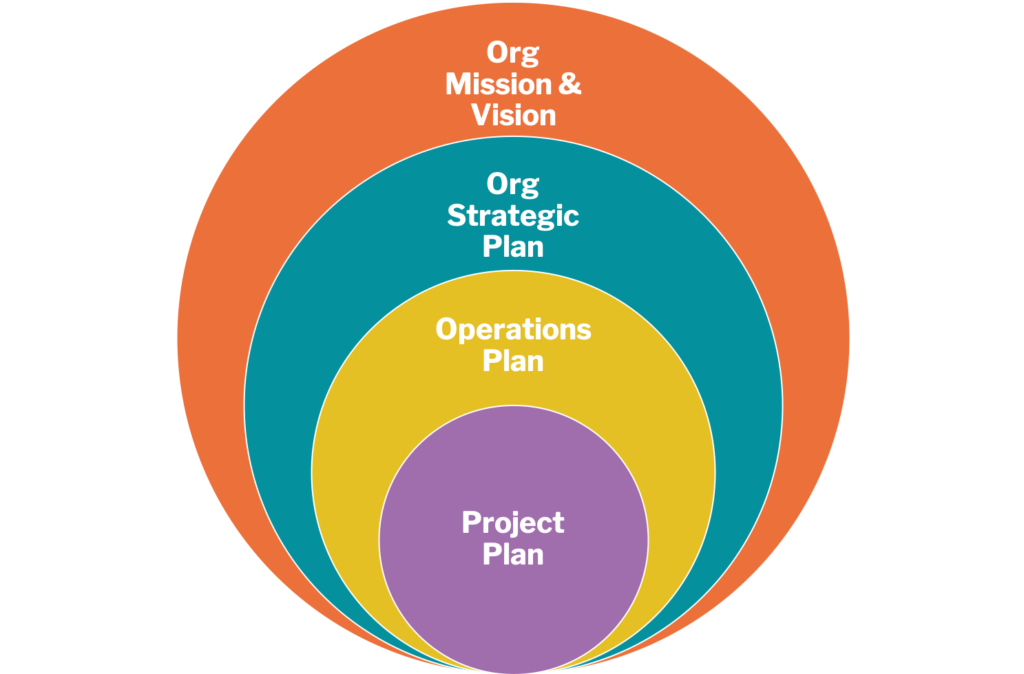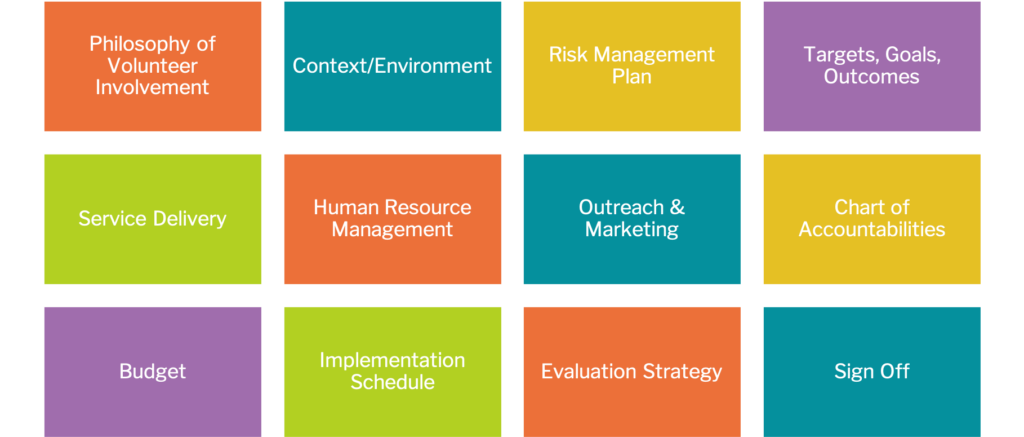For many volunteer organizations, the slow(er) season of late summer/early fall is approaching. This is always a great time to get back to basics and review the overall volunteer strategy and processes for your organization. It’s an opportunity to take a breath and think the big thoughts about your department that there simply isn’t time for the rest of the year.
With this in mind, todays’s blog is going all the way to the beginning to look at how to build a foundational operations plan for your volunteer program.
Volunteer Strategy Starts with an Operations Plan
If you don’t know where you’re going, chances are you won’t get there. So, a key element to successful nonprofit volunteer strategy is to develop a volunteer program model, or an “operations plan.”
An operations plan for volunteer services can help organizations think through their entire strategy – soup to nuts – and build a roadmap for success.
As human resources and talent for the organization, volunteers are a vital fuel to getting things done. So, the plan should relate directly to the agency’s strategic plan and be aligned with the goals and objectives for the coming years.
The Context of an Operations Plan for Nonprofit Volunteer Programs
While most nonprofit staff believe they don’t have the time for planning, a well-considered volunteer strategy can actually save time in the long-term by pinpointing possible barriers to success so they can be dealt with in a proactive way.
An operations plan for volunteer services can also help clearly describe to potential funders how you involve the community directly in your mission, what resources are required for full volunteer engagement, and how you are a responsible steward of funds.
Using the chart above for inspiration, set aside some dedicated time to develop a complete “Operations Plan for Volunteer Involvement” that will serve as a blueprint. Like other strategic plans, it should be reviewed and approved by the agency’s governing board before it is implemented.
Once the plan is complete, brief staff on what it contains and what their respective roles are with respect to the plan and volunteers. Supporting volunteers is everyone’s job, and all employees need to understand their roles and responsibilities with respect to their interactions with these supporters.
Operations Plan Components
Volunteer operations plans should include the following elements:
- Scope/duration (generally annual)
- Purpose (to improve the impact of volunteer services)
- Lifecycle (to coincide with the agency’s fiscal year)
- Planning Team (volunteer coordinators, executive leadership, key volunteers, consultant, etc.)
- Agency Strategy (how the operations plan aligns with the agency’s current strategic plan and direction)
- Philosophy of Volunteer Involvement (statement regarding the value of volunteers and why they are considered a strategic asset)
- Core Values (the vision and ethical foundations that drive the plan)
- A Logic Model and Key Performance Indicators (theory of change, expected outcomes, and how its performance will be assessed)
- Environmental Scan (or SWOT Analysis of local context; what will affect volunteering)
- Advertising/Promotions/Marketing (for volunteer program branding and volunteer recruitment, also includes the digital presence)
- Operating Budget for Volunteer Services (cost and funding sources with 10% contingency, can also include planned in-kind resources)
- Service Delivery (volunteer roles in service delivery and customer service standards)
- Staffing and Chart of Accountability (CoA) (human resources that will support the volunteer strategy and who is ultimately responsible for which tasks, including paid staff and key volunteer roles)
- Resources (material sources that will be leveraged or purchased to support volunteer involvement from across the agency)
- Plan Evaluation (methods and planned schedule)
Good volunteer strategy aligns with the agency’s overall goals. You can use this free Goal Cascade Worksheet to help define those goals more easily. Download the worksheet HERE>>
Volunteer Strategy Includes the Org Chart
When developing your volunteer strategy, the question may arise about where the volunteer team should live within your organization. Should it be included as a part of donor development, human resources, as separate programs throughout the agency, or in its own department? The options are varied.
If volunteers are a fundamental key to your success across your organization, then a dedicated Volunteer Services Department may be a good idea.
A focused team can help sustain, diversify, and grow involvement without distraction and can help standardize volunteer processes and support coach staff as they implement them.
In terms of the number of staff required, it will depend on the strategic goals and activities the department will assume, and the specific tasks required to meet those goals.
At the very least, based on the current scope of volunteer involvement and the goal of diversifying and integrating volunteers across the agency, the department should be led by a Director of Volunteer Services who should have a seat at the management table.
Options for Locating Nonprofit Volunteer Programs
The location of choice should be based on the overall volunteer strategy for your organization, where the maximum integration will most likely occur throughout the agency, and where there is departmental capacity, understanding, and enthusiastic support for the volunteer function.
There are pros and cons to where the volunteer services department is placed within the organization. Below are some options with things to consider:
OPTION 1: Stand-alone Department Reporting to Executive VP/Human Resources
- Pros
- Communicates that volunteer involvement is of primary, strategic importance to the agency
- Volunteers are recognized as a vital element of mission delivery
- Seat at executive leadership table, thus increasing first-hand knowledge of volunteer program progress and needs
- Better coordination with paid staff human resources systems
- More likely viewed as a solely human resources specialist for unpaid staff
- Cons
- Isolates volunteer services
- Risk of becoming siloed and reducing agency-wide “ownership” of volunteer strategy
- Staff may feel that volunteers belong to the department and are not the responsibility of other staff
- May reduce levels of collaboration and trust in sharing concerns and needs
- Volunteer management staff may be diverted to other work, unrelated to volunteers
- Volunteer involvement needs creative resource management, paid staff models generally have set budgets, may create tension
OPTION 2: Development Department, Reporting to Director of Development
- Pros
- Better coordination of supporter communication and resource cultivation
- Better collaboration around outreach, partnership development, specifically corporate donors
- Encourages acknowledging the reality of volunteers as donors
- Better likelihood of accurate tracking of in-kind support
- Increased efficiencies if a software system is shared
- Cons
- Danger of volunteers viewed as an ancillary resource, versus revenue generator, and thus under-supported
- Department is not directly linked with service delivery, but volunteers are
- Risk of volunteer perception that they are valued for financial contributions over donations of time and talent
OPTION 3: Marketing & Communications Department, Reporting to VP of Marketing & Communications
- Pros
- Sends the message that volunteers are the “face” of the organization
- Better coordination of email communications and social strategies and schedule for both recruitment and recognition
- Better relationships with reporters and the press
- Better collaboration around outreach and partnership development, specifically event sponsors
- Faster updates of the web site landing page(s) related to volunteers
- More coordinated Search Engine Optimization (SEO) strategy to raise the agency’s organic search ranking
- Can get help designing professionally-branded volunteer application and training materials & help with effective copywriting
- Increased efficiencies if contact database and communications software is shared
- Cons
- Risk of focusing primarily on volunteer program branding and recruitment versus management and retention
- Can appear that volunteers are “for show” versus a mission critical element of the agency’s operations
- Other staff may lack understanding of the unique messaging required for the volunteer audience
- Danger of lack of attention and resources in a busy department where ticket sales may have priority over volunteers
OPTION 4: Outreach & Community Partnerships Department, Reporting to VP or Program Director
- Pros
- Acknowledges volunteers as valued community partners and viable service providers
- Appropriately sits at the nexus between the organization and the community
- More focus on corporate social responsibility and employee volunteering opportunities
- Promotes ongoing partnership development and maintenance, a key tactic for diversifying volunteer base
- Better collaboration around outreach and partnership development
- Reduces duplication through better alignment of strategic partnership goals and community engagement plans
- Better solicitation of in-kind support from community
- Cons
- May not be sufficient room for volunteer services in a smaller department, without the capacity to focus resources and support
- Department is not directly linked with service delivery, but volunteers are
- Risk of becoming siloed and reducing agency-wide “ownership” of volunteer strategy
- Risk of focusing primarily on partnerships and recruitment versus management and retention
- Danger of prioritizing partner needs over nonprofit volunteer programs’ needs in order to maintain external relationships
OPTION 5: Guest or Client Services Department, Reporting to VP or Program Director
- Pros
- Recognizes volunteers as a key element of the customer or client experience
- Can better coordinate customer service and recovery standards across paid and unpaid teams
- Can more quickly address customer issues
- Can more quickly address potential burnout in volunteers
- Can coach volunteers on the fly at close quarters
- Cons
- Focuses primarily on volunteers as direct service help versus a broad range of roles
- Volunteers may become hidden in this department and endanger the opportunity for widespread integration
- More prone to a blurring of roles between paid staff and volunteers
- Paid staff may (irrationally) fear volunteers will usurp their roles and be less supportive
OPTION 6: Special Events Department, Reporting to VP or Program Director
- Pros
- Faster response to upcoming event recruitment needs
- Recognizes volunteers as a key element of risk management and customer safety
- Can better coordinate safety and security standards across paid and unpaid teams
- Can quickly update volunteers on security upgrades and policy changes
- Easy access to the upcoming event schedule
- Ability to build camaraderie amongst episodic event volunteers through a single department structure
- Cons
- Risk of becoming siloed and reducing agency-wide “ownership” of volunteer strategy
- Volunteers may become hidden in this department and endanger the opportunity for widespread integration
- Can appear that volunteers are more one-off event help or a security team than an integrated agency resource
- Some volunteers are reluctant to perform security or event tasks
- Focuses primarily on volunteers as event staff versus a broad range of roles
- May be easy to get “lost” in a large department with high-paced daily production needs
- No connection with the human resources side of volunteerism
Want to explore more options for where Volunteer Services should live at your nonprofit? Check out Episode 8 of the Volunteer Nation Podcast HERE>>
In the end, there is no “right answer” in terms of where nonprofit volunteer programs should be placed within the organization’s structure. The answer that’s best for you will arise from your overall volunteer strategy.








